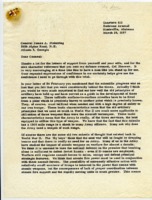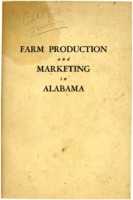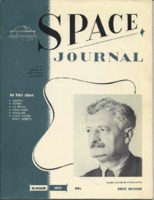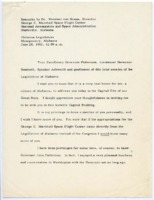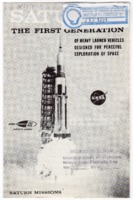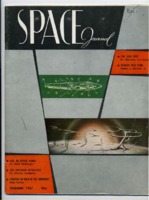
Browse Items (2178 total)
Sort by:
-
Abbreviated timeline of the Apollo 11 mission.
The timeline includes a memorandum from Friedjof A. Speer, manager of the Missions Operations Office, to employees of Marshall Space Flight Center. Speer notes that "astronaut Neil Armstrong is scheduled to be the first man to step onto the moon's surface." The timeline outlines the entire mission from liftoff at 8:32 AM on Wednesday, July 16, 1969 to splashdown at 11:49 AM on Thursday, July 24, 1969. -
Letter from Col. John C. Nickerson at Redstone Arsenal in Huntsville, Alabama, to Gen. James A. Pickering in Atlanta, Georgia.
In this letter, Nickerson thanks Gen. Pickering for his support and explains why he believes the Army is the best service branch to develop ballistic missiles. He also discusses the need for missiles in case of war with the Soviet Union. Nickerson was a staff officer at the Army Ballistic Missile Agency at Redstone Arsenal assigned to work on the Jupiter, the United States' first mid-range ballistic missile. He was arrested and court martialed for espionage in 1957 after releasing sensitive documents about the United States missile program to the press. At the time, Secretary of Defense Charles E. Wilson granted the Air Force sole authority to develop intermediate range ballistic missile systems. Nickerson disagreed with this policy, and in response, leaked documents that demonstrated the superiority of Army missiles compared to those developed by the Air Force. He eventually pled guilty to lesser charges and was suspended from the Army for one year and was fined $1,500. Dr. Wernher von Braun was among those who testified on Nickerson's behalf. -
Space Journal, vol. 1, no. 1., Summer 1957.
This issue of Space Journal includes articles written by Fred L. Whipple, Hermann Oberth, and Ernst Stuhlinger, as well as a foreword by Wernher von Braun. The issue also includes drawings for an observatory to be built at the top of Monte Sano Mountain in Huntsville, Alabama. Produced by the Rocket City Astronomical Association (now known as the Von Braun Astronomical Society), Space Journal was published in Huntsville from 1957 to 1959. This digitized copy was generously provided by Jeff Bennett at the Von Braun Astronomical Society (VBAS). -
"Your Family Survival Plan."
The pamphlet instructs readers how to build a fallout shelter and includes instructions for storing food and water, specifications for building materials, and charts for keeping track of food and water supply, shelter supplies and equipment, and first aid. -
Transcript of a speech given by Wernher von Braun to the Alabama Legislature.
Von Braun, then the director of Marshall Space Flight Center in Huntsville, Alabama, delivered this speech to the legislature in 1961. In the speech, he emphasizes that Alabama must take advantage of its position in the aerospace industry and create a robust "academic and research environment" in Huntsville to attract businesses that "will give birth to major new industries throughout the state." He exhorts the legislature to fund the newly established University of Alabama Research Institute (now part of the University of Alabama in Huntsville), arguing that "the Institute will not only be self-sustaining, but will enrich the State both financially and culturally." The legislature later approved von Braun's request of $3 million for the Research Institute, enabling the purchase of 200 acres of land for the campus and the construction of the Institute in 1964. The speech includes copies of slides von Braun used during his presentation, including diagrams of Saturn and Nova rockets as well as a mockup of a Saturn rocket on the lawn of the state capitol in Montgomery. -
"Saturn I: The First Generation of Heavy Launch Vehicles Designed for Peaceful Exploration of Space."
The leaflet outlines the history of Saturn launches and gives a physical description of the rocket. The description includes a diagram of each stage; specifications of each stage's thrust, propellants, liftoff weight, and burning time; and engine specifications. -
Transplanted Rocket Pioneers.
The information in this dataset is reproduced from Charles Lundquist's 2014 monograph Transplanted Rocket Pioneers. The information includes biographical and professional information that he compiled to produce the book. Each individual represented in the dataset also has a vertical file in the Lundquist Collection at UAH.
Transplanted Rocket Pioneers is a recognition of the early members of the von Braun rocket team, many of whom were key players in the successful moon landing. Many historians conclude that the lunar missions of the Apollo Program could not have been possible without the leadership and experience provided by a corps of engineers, scientists and managers transplanted from Europe to the Unites States after World War II. This fact motivated Dr. Lundquist to deposit this work in the Archives of the Library at the University of Alabama in Huntsville by assembling a file on each of the individuals who came from Europe to participate in the rocketry activities in Huntsville, or, in a few cases, individuals who had other ties to Huntsville.
This dataset includes a standard one-page summary sheet for each subject. Although most sheets are relatively complete, some data are still missing.
The first two lines on each page records fundamental identification information:
Family name Date of birth Place of birth Given names Date of death Place of death
The next standard entry is a statement of the extent of the Archives Holdings, either i) A primary collection of documents housed in one or more banker boxes, usually a separate individual collection ii) A secondary collection in a standard archive box, or iii) a file folder. Next, if there is an oral or video history for the individual, this fact is noted. A statement about the highest education levels of the individual follows. The next five entries, in chronological order, record whether the individual participated in activities at five sites:
1. Raketenflugplatz-Kummersdorf: Individuals engaged in the activities at these sites of early rocket development experiments sponsored first by VfR and subsequently by the German Army.
2. Peenemünde: Included here are individuals who participated in Peenemünde programs under several auspices, including as Army civilian employees, as members of the German military, as contractor employees on site or visiting as needed, and as university employees collaborating as required.
3. Fort Bliss: Individuals who were brought to Fort Bliss from 1945 to 1950.
4. GMDD-ABMA: Individuals who came to Huntsville, Alabama to work for the US Army rocket programs in the decade 1950 to 1960.
5th MSFC: Individuals who were employed by the NASA Marshall Space Flight Center in the 1960s.
Some people had various relationships with UAH and that is so noted. Additionally, a statement of immigration details is noted if pertinent. Finally, a great variety of incidental information is included under Incidental Remarks.
UAH Special Collections welcomes additions of biographical materials to the vertical file in the Charles Lundquist Collection. Please note that the work is that of Dr. Lundquist and may contain errors or omissions which are solely the product of his work on the project, as noted in the introduction of the work.: " Finally, it is pertinent to note that any document containing large files will surely have some mistakes or omission. Any errors are the responsibility of the author alone." As was the wish of Dr. Lundquist, we will strive to make factual corrections to the online copy when necessary.

